
The South was the center of rural population growth last year
This story was produced by The Daily Yonder and reviewed and distributed by Stacker Media.
The South was the center of rural population growth last year
The Southeastern U.S. was responsible for nearly 90% of the population growth that occurred in rural America last year, a Daily Yonder analysis of 2023 Census Bureau data shows.
From 2022 to 2023, nonmetropolitan (rural) counties in the South grew by 0.54%, adding an estimated 95,800 residents. Nationally, rural America gained 108,000 residents, meaning rural counties outside the South added only 12,200 people. Rural America overall grew by about 0.24% last year, as we previously reported.
The growth in the rural South came from people moving into rural counties, not from births. About 143,800 people moved to rural southern counties from 2022 to 2023; 86% of those transplants came from other parts of the U.S.
The population growth rate in the metropolitan South was more than twice the rate of growth in the region's rural counties. The metro South's population climbed by an estimated 1.36%, an increase of 1.3 million residents from 2022 to 2023.
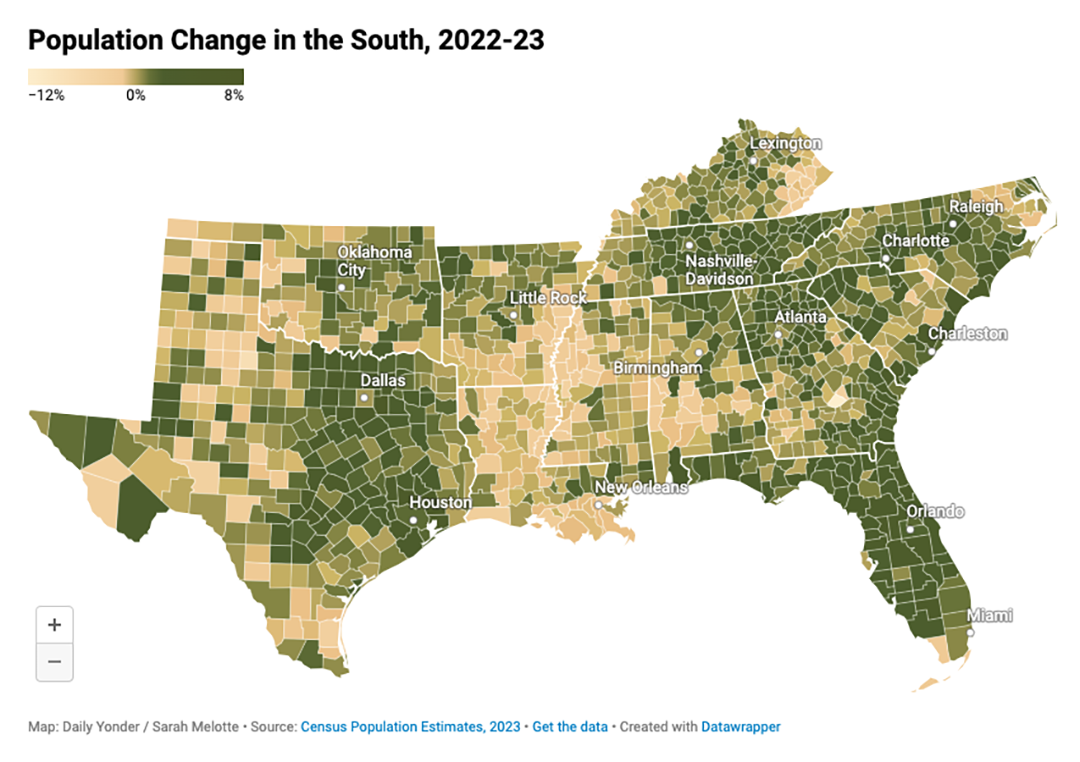
Population Change Varied by Region
The rural South showed the greatest influx in the number of residents, while some regions saw slight drops in population.
Counties in the Coastal West, an area that includes the states of California, Washington, and Oregon, had one of the greatest percent decreases in rural population compared to all other regions. Between 2022 and 2023, rural counties in California, Washington, and Oregon lost 4,900 rural residents, a 0.21% decrease in population.
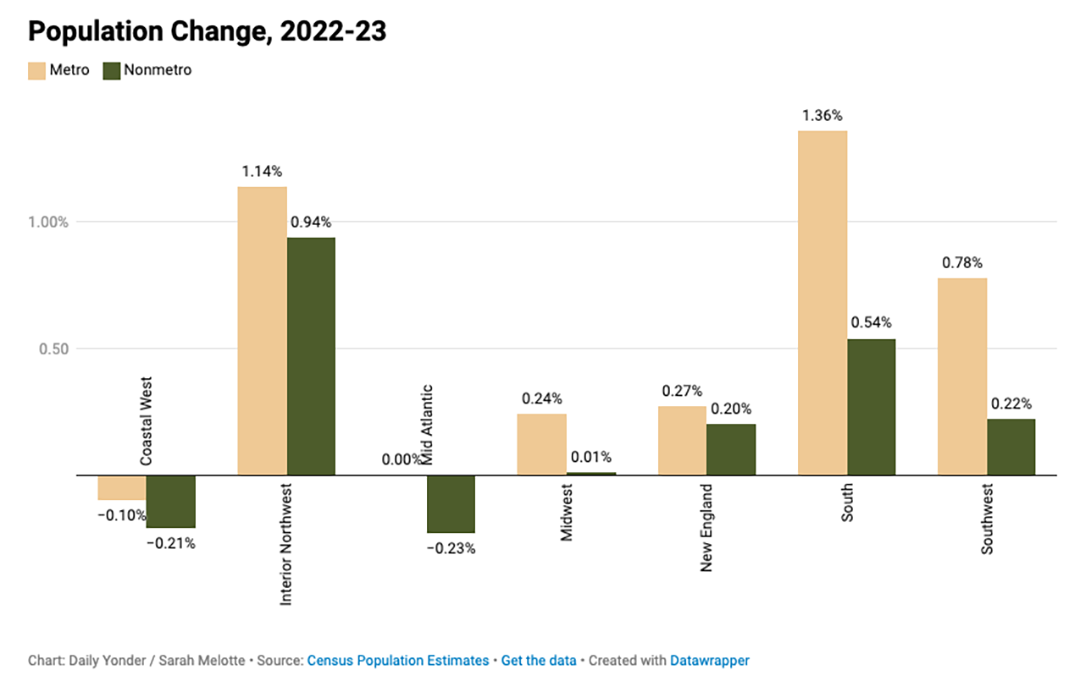
Interior Northwest's Nonmetropolitan Counties Show Population Gains
The only other region that lost rural residents between 2022 and 2023 was the Mid Atlantic, which lost 10,800 residents, a 0.23% decrease in population.
Although the South gained the greatest number of rural residents, nonmetropolitan counties in the Interior Northwest showed the greatest percent change in population growth compared to other regions. The Interior Northwest includes the states of Wyoming, Montana, and Idaho. From 2022 to 2023, the Interior Northwest gained 16,600 rural residents, almost a 1% change in population growth.

Migration to the Rural South
Population growth in the last year in the rural South came primarily from migration. If it weren't for people moving to the rural South, southern nonmetropolitan counties would have lost 48,000 residents.
From 2022 to 2023, deaths outnumbered births in the rural south, a phenomenon demographers refer to as natural decrease. About 203,100 people were born in rural southern counties between 2022 and 2023, while just over 251,000 people died there. When we accounted for the number of people who moved to the rural South, the resulting net change in population was a gain of 95,800 residents, a 0.54% increase.
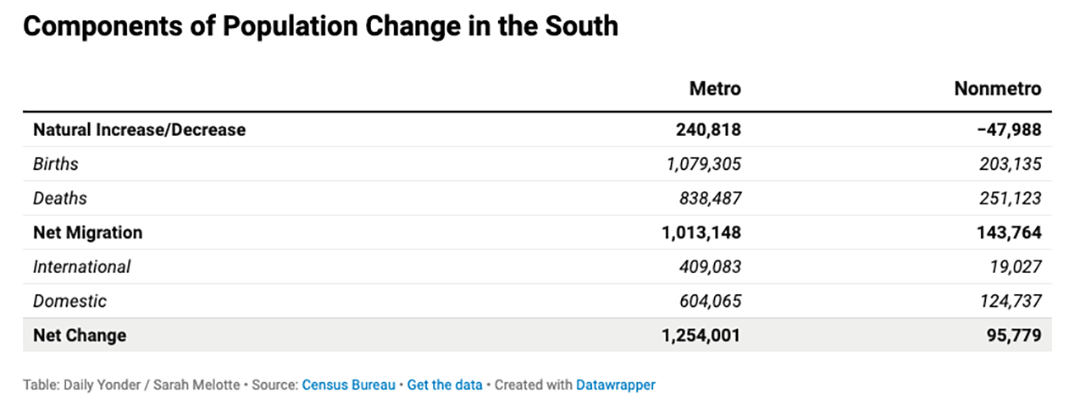
Births and Migration Account for Growth
In southern metropolitan counties, meanwhile, there were more births than there were deaths between 2022 and 2023. These counties gained 240,800 residents because of natural increase and an additional 1 million residents because of migration. The net increase in population was 1.3 million residents, a 1.4% change since 2022.
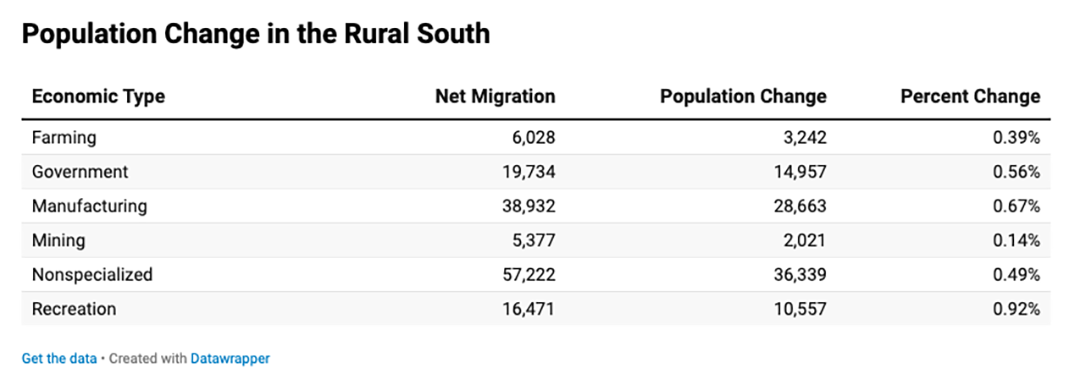
Rural Counties Dependent on Tourism Show Largest Percent Change in Population
Population growth was the greatest in rural counties where the economy was built on tourism, recreation, or outdoor activities like hiking and skiing.
From 2022 to 2023, rural recreation counties in the South gained 10,600 residents, a 0.92% change in population.
Georgetown County, South Carolina, is a rural tourism town on the coast that gained 1,000 residents in 2023, a 1.64% increase from 2022. The population of Georgetown County was 65,700 in 2023, up from just over 64,000 the previous year.
Rural counties where the economy was dependent on mining and natural resource extraction saw the least amount of population growth compared to other economic sectors. Mining counties saw a 0.14% increase in population with the addition of about 2,000 rural residents.
The population in farming-dependent counties grew by about 3,200 residents between 2022 and 2023, meanwhile. That's a 0.39% increase in population.
Rural counties where manufacturing was the dominant industry saw an increase of 28,700 residents in 2023 compared to 2022, a 0.67% increase.
In rural counties where the government was the primary economic force, the population increased by 0.56%, or 15,000 residents.
Rural counties that were nonspecialized, or where no particular industry dominated the economy, saw the greatest increase in the number of residents from 2022 to 2023. Population increased in rural nonspecialized counties by 36,300 residents, a 0.49% increase.
The county economic types are based on categories created by the USDA's Economic Research Service.
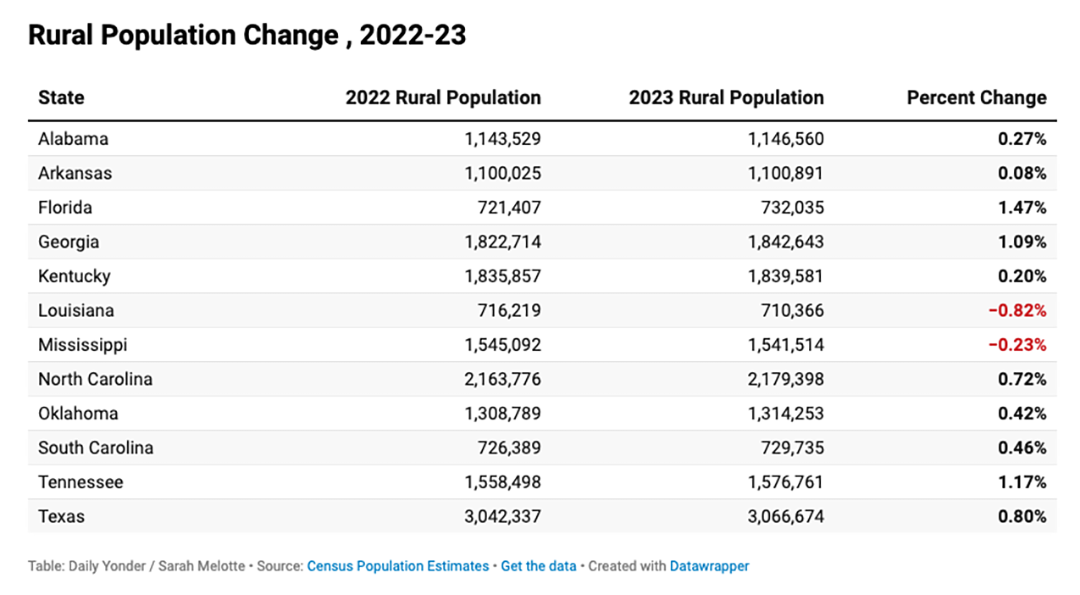
Rural Population Declined in Louisiana and Mississippi
From 2022 to 2023, Louisiana and Mississippi were the only southern states to show a decrease in rural population. Louisiana lost 5,900 rural residents, a 0.82% decrease in population, while Mississippi lost 3,600 rural residents, a 0.23% decrease in population.
In Louisiana, rural population loss happened in conjunction with overall population decline in the state. Louisiana was the only state in the southeastern U.S. to see declines in both rural and metropolitan residents. Between 2022 and 2023, Louisiana lost 8,400 urban residents, a 0.22% decrease in population.
Most of the population decline in Louisiana was due to out-migration, not deaths. From 2022 to 2023, 4,500 people left rural counties in Louisiana, accounting for about 77% of the state's total rural population loss.
In 2023, 716 people left St. Mary Parish, Louisiana, which has an economy dependent on salt mining. The coastal parish was home to 47,000 residents in 2023. When accounting for additional losses because of natural decrease (births minus deaths), the population of St. Mary declined by 764 residents, a 1.6% drop.
Interviews from Louisianan expats in 2023 found that lack of employment opportunities and rising insurance rates were among some of the reasons people were deciding to leave.
In Mississippi, however, rural population loss happened primarily because of natural decrease, in which deaths outnumbered births. In rural Mississippi, 21,000 people died from 2022 to 2023, while about 19,000 people were born. About 1,200 residents moved out of rural Mississippi counties in the meantime, which accounted for about a third of the total rural population loss in the state.
Rural Lauderdale County, Mississippi, for example, lost 615 residents between 2022 and 2023, a 0.86% drop in population. Sitting on the Mississippi-Alabama border, about 100 miles east of Jackson, Mississippi, Lauderdale County was home to about 70,000 residents in 2023.



